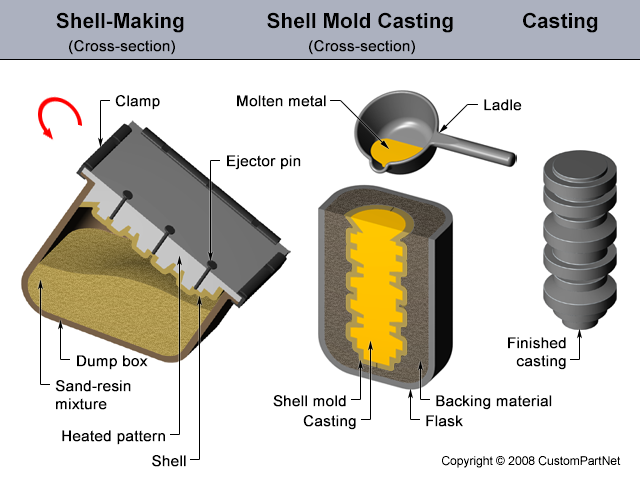Exploring how Metal Castings influence today’s manufacturing industries
A Deep Study the Different Kinds Of Metal Casting and Their Utilizes
Metal Casting includes numerous strategies, each customized for particular applications and requirements. From the cost-efficient sand spreading approach to the accuracy of financial investment casting, each process has special benefits. Die casting attracts attention in high-volume production circumstances, while lost foam spreading presents innovative layout possibilities. Additionally, permanent mold and mildew spreading is identified for its durability. Recognizing these techniques opens a window right into their useful uses and ramifications in numerous sectors. What exists beneath the surface of these spreading methods?
Sand Casting: A Versatile and Affordable Approach
Although various casting approaches exist, sand casting stays one of the most functional and cost-effective methods in the metalworking sector. This method uses a mix of sand and a binding agent to create mold and mildews, enabling the manufacturing of parts in varied shapes and sizes. Sand spreading is specifically advantageous for tiny to tool manufacturing runs, as it requires marginal upfront financial investment in tooling contrasted to various other casting methods.
The procedure starts with the development of a mold and mildew, where liquified steel is gathered to develop the preferred things when cooled. Its versatility enables making use of different steels, including aluminum, iron, and steel. In addition, sand spreading can accommodate complex geometries, making it appropriate for a variety of applications, from auto elements to elaborate artistic items. In general, sand casting's efficiency and versatility solidify its significance in the manufacturing landscape.
Financial Investment Spreading: Accuracy and Detail for Complex Shapes
Investment casting attracts attention as a method renowned for its capability to create extremely outlined and elaborate components. This process involves developing a wax pattern that is covered with a ceramic covering, which is after that heated to remove the wax and solidify the shell. The result is an exact mold that can capture complicated geometrical shapes with impressive precision.
This casting technique is specifically advantageous for creating get rid of slim wall surfaces, fine functions, and limited tolerances, making it excellent for markets such as aerospace, vehicle, and clinical tools. Investment spreading fits a variety of metals, consisting of stainless-steel, light weight aluminum, and titanium, making it possible for makers to fulfill details material requirements.
The process lessens machining demands post-casting, which can improve performance and lower production costs. Overall, investment spreading is a favored choice for applications where accuracy and detail are vital.
Die Casting: High-Volume Production With Excellent Surface Finish

Pass away spreading is an extremely efficient production process that masters producing big quantities of metal parts with extraordinary surface coatings. This method includes requiring molten steel into a mold tooth cavity under high stress, enabling quick manufacturing cycles and uniformity in the completed items. Generally utilized products consist of light weight aluminum, magnesium, and zinc, which supply exceptional mechanical buildings and deterioration resistance.
Pass away spreading is specifically beneficial for sectors such as vehicle, electronic devices, and consumer items, where precision and quality are vital. The process allows complex layouts, lowering the requirement for additional machining and ending up processes. Additionally, the smooth surfaces developed through die spreading usually require minimal post-processing, leading to reduced general manufacturing expenses. As a high-volume production strategy, pass away spreading is excellent for makers seeking effectiveness without endangering on quality, making it a recommended selection for countless applications throughout numerous sectors.
Lost Foam Casting: Ingenious Technique for Intricate Designs
Lost foam casting reinvents the production of complicated metal components by making use of a distinct procedure that eliminates the demand for traditional molds. Instead of traditional mold-making, this method utilizes a foam pattern that is covered with a refractory material. When the pattern is set, liquified steel is poured directly right into the mold, triggering the foam to vaporize and leave behind an exact cavity for the steel to fill up. This cutting-edge method enables detailed styles and in-depth functions that might be testing to achieve with various other casting approaches.
Furthermore, lost foam spreading can reduce waste and energy consumption, making it an eco-friendly option. Industries such as auto and aerospace benefit substantially from this technique, as it sustains the production of lightweight parts with complex geometries. Overall, shed foam casting attracts attention for its capacity to provide high-quality, customized metal components effectively.
Long-term Mold And Mildew Spreading: Longevity and Uniformity in Metal Components
Irreversible mold and mildew casting is a highly reliable method for generating durable and consistent steel components, leveraging recyclable mold and mildews that are generally made from metals such as iron or steel. This spreading process entails pouring molten steel into these mold and mildews, which are preheated to improve item top quality and reduce defects. Making use of multiple-use molds not only lessens waste but additionally permits greater production click over here rates, making it economically useful for manufacturers.
The resulting parts exhibit outstanding dimensional precision and surface area coating, making them optimal for applications in vehicle, aerospace, and commercial machinery. Additionally, long-term mold and mildew spreading can suit a selection of alloys, additionally increasing its convenience. The durability of the cast components is improved due to the regulated cooling rates that promote finer grain structures. Generally, this spreading strategy attracts attention for its capability to create high-grade steel parts that satisfy extensive performance requirements, making certain integrity sought after atmospheres.
Often Asked Inquiries
What Materials Can Be Used in Different Metal Casting Processes?

Different materials can be made use of in Metal Casting processes, consisting of light weight aluminum, zinc, bronze, and iron. Each product supplies one-of-a-kind residential properties, influencing the spreading technique's efficiency, toughness, and viability for different applications in manufacturing.
Just How Do Casting Methods Affect the Mechanical Residences of Metals?
Casting approaches significantly influence the mechanical residential properties of metals, influencing variables like ductility, firmness, and stamina. Variations in cooling down prices and mold products can result in different microstructures, inevitably affecting the performance of the end product.
What Are the Ecological Effects of Metal Casting Processes?
Metal Casting processes can bring about air and water air pollution, source depletion, and substantial energy consumption (Aluminum Castings). In addition, the generation of waste materials and greenhouse gas exhausts considerably contributes and affects the setting to climate modification
Exactly how Do You Pick the Right Spreading Approach for a Task?
Choosing the ideal casting technique includes examining task demands, material residential properties, complexity, and production volume. Variables like expense efficiency, coating top quality, and lead time likewise play vital functions in establishing the most suitable technique.
What Security Precautions Should Be Taken During Metal Casting Procedures?
During Metal Casting operations, safety and security precautions include wearing protective gear, guaranteeing correct ventilation, performing tools examinations, keeping a clean workspace, and having emergency situation procedures in position to deal with more information prospective threats like burns or harmful fumes.
From the cost-effective sand spreading approach to the accuracy of investment casting, each process has special benefits. Pass away spreading is a highly reliable production procedure that succeeds in producing huge volumes of metal parts with extraordinary surface coatings. Lost foam casting revolutionizes the production of complex steel components by using an one-of-a-kind process that eliminates the demand for standard click for more mold and mildews (Aluminum Foundry). Long-term mold and mildew casting is an extremely reliable approach for generating consistent and sturdy metal parts, leveraging reusable mold and mildews that are commonly made from steels such as iron or steel. Various products can be used in Metal Casting processes, consisting of light weight aluminum, zinc, bronze, and iron